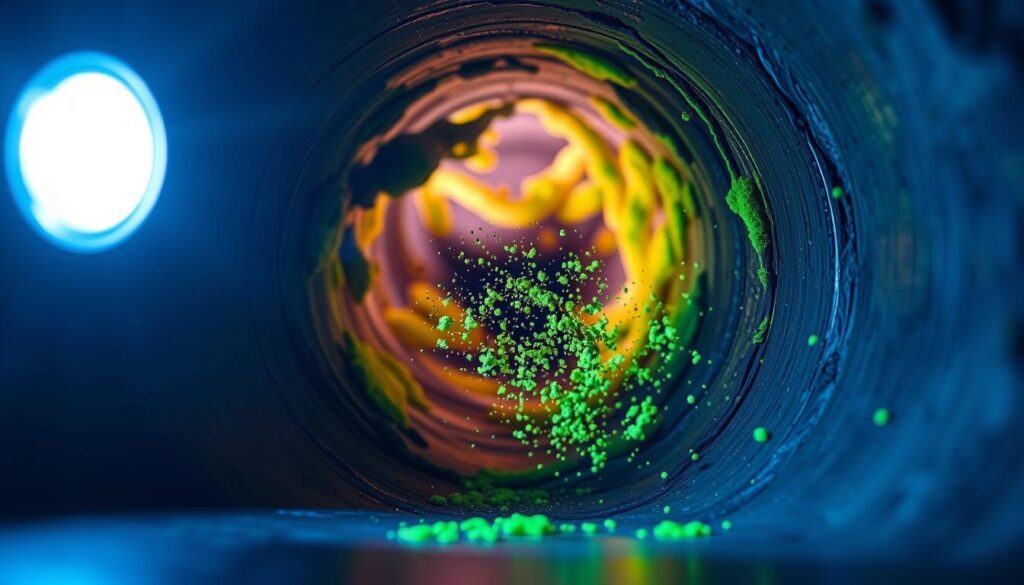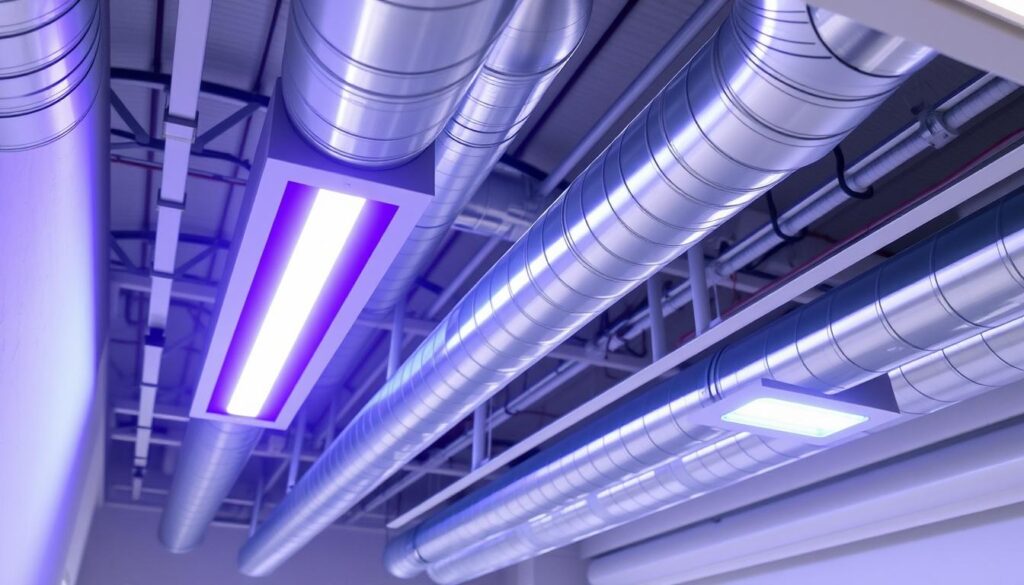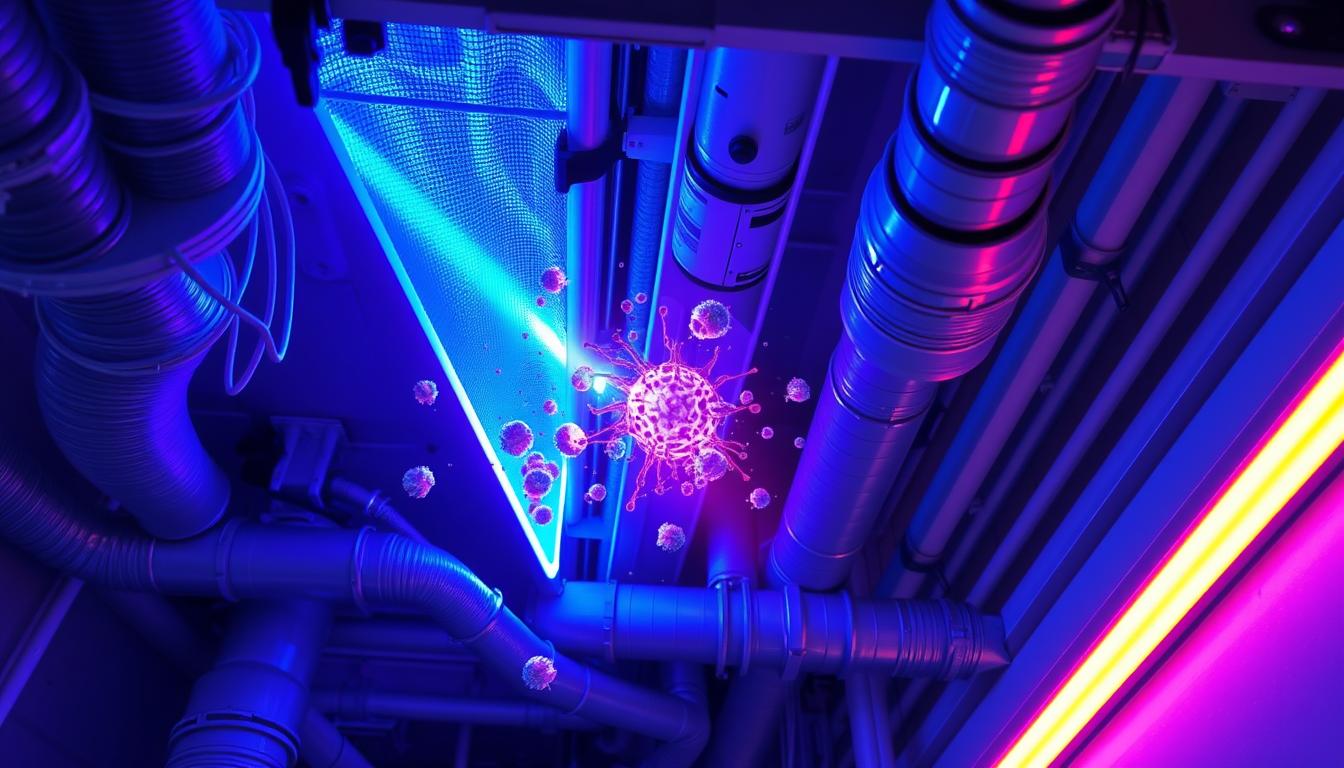UV Light vs Mold in Ducts: Does UV Light Kill Mold?
Mold, mildew, fungi, and bacteria love cool, dark, and damp places. They often hide in HVAC systems. The United States Environmental Protection Agency (EPA) says up to 50% of homes have mold. As a professional writer, I’m looking into if UV light can kill mold in HVAC ducts.
Mold grows a lot in basements because of the humidity. But it’s not just basements. HVAC systems, with their moisture, dark spots, and dust, are perfect for mold. This harms the air we breathe and can be dangerous, especially for people with asthma or allergies.
Key Takeaways
- UV light systems in HVAC systems can effectively kill mold when properly designed and installed.
- Mold thrives in dark, wet, and cool areas of homes, making HVAC systems an ideal breeding ground.
- Ultraviolet germicidal irradiation (UVGI) cleaners using UV lamps can destroy indoor biological pollutants, including viruses, bacteria, and some molds.
- Professional installation of UV lights in HVAC systems is crucial for effective mold prevention.
- UV lights in HVAC systems are beneficial for households with members who suffer from asthma or severe seasonal allergies.
Understanding Mold Growth in HVAC Systems
Mold loves the dark, damp spots in HVAC systems. It finds plenty of food in the dust and debris that gets trapped. Places like ductwork, evaporator coils, and drain pans are hotspots for mold. This can harm indoor air quality solutions and make people sick.
Why Ducts Are Perfect for Mold Growth
Ductwork is a mold’s dream home. It’s dark, damp, and full of dust and dirt. To keep the air clean and healthy, duct sanitization methods are key.
Common Areas of Mold Infestation
- Evaporator coils: The moist environment and collected debris make coils susceptible to mold growth.
- Drain pans: Clogged or leaky drain pans can lead to standing water, fueling mold proliferation.
- Ductwork: Leaks, poor insulation, and accumulated dust provide the conditions for mold to thrive in ductwork.
Impact on Indoor Air Quality
Mold in HVAC systems spreads spores everywhere in the house. This can make breathing hard for people with asthma or allergies. If mold isn’t stopped, it keeps spreading, putting everyone’s health at risk.
“Mold spores are always present in the air but become visible when they land on a damp surface and begin to grow.”
Does UV Light Kill Mold in Ducts
Yes, UV light is a great way to kill mold in HVAC ducts. The EPA says UV germicidal irradiation (UVGI) cleaners can destroy on moist surfaces like evaporator coils and ductwork. This improves air quality and lowers health risks from mold.
UV rays kill mold by stopping it from growing. In-Duct UV Light Systems can cut mold and bacteria levels in HVAC systems by up to 99%, says ASHRAE. Also, UV air purifiers with HEPA filters can drop mold spore counts by over 90% in 48 hours, a study found.
The best UV light for mold is UVC, with wavelengths between 200 to 280 nanometers. Portable UV lamps need 15 minutes to an hour to treat mold, based on growth. In-duct UV systems and UV air purifiers can see big drops in mold spores in 24-48 hours. It might take days or weeks to fully get rid of mold.
For the best results, get professional installation of UV lights in HVAC systems for mold prevention. Well-designed UV systems can kill indoor pollutants like viruses and molds. This is great for homes with asthma or severe allergies.

“UV lights in air conditioning systems can eliminate the viability of mold spores, bacteria, viruses, and some volatile organic compounds (VOCs).”
The Science Behind UV Light Disinfection
Ultraviolet (UV) light is a strong tool against mold in HVAC systems. But how does it kill mold spores? The science behind UV light disinfection is both interesting and effective.
How UV Light Affects Microorganisms
UV light, especially the UV-C range, is great at killing germs. This type of ultraviolet radiation has the shortest wavelength and most energy. It damages the DNA and RNA of microorganisms.
When UV-C light hits mold, bacteria, or viruses, it messes with their genetic material. This stops them from making copies and kills them off.
Types of UV Light Systems for HVAC
- Coil-sanitizing UV lights: These are made to kill mold and bacteria on the evaporator coil. They run all the time during the cooling season to stop growth.
- Air-sanitizing UV lights: These are put in the return or supply plenum of the HVAC system. They kill airborne microorganisms as they move through the ductwork, making the air cleaner.
The success of UV light in fighting mold depends on several things. These include the light’s intensity, how long it’s on, and the type of mold. It’s also important to install and maintain it right to work best.
“UV light, especially UV-C light, is known for its germicidal properties. It can effectively kill or inactivate many microorganism species, including mold spores.”
Using UV light helps keep HVAC systems healthy and mold-free. This technology, along with regular HVAC maintenance tips, is key. It helps with ultraviolet air purification and makes indoor spaces safer and more comfortable.
Benefits of UV Light Installation in Ductwork
Looking for ways to improve your indoor air? UV light in your ductwork is a great choice. It fights mold, bacteria, and other harmful particles in the air.
UV light is great at stopping mold in HVAC systems. Mold grows in ducts because of dirt and other stuff. UV-C light kills mold spores, stopping them from spreading.
UV light also kills bacteria and viruses in your home’s air. This is good for people with asthma or allergies. It helps reduce air triggers.
UV lights in your ductwork can also make your HVAC system work better. They keep it clean, saving energy and extending its life.
| Indoor Air Quality Solutions | Duct Sanitization Methods |
|---|---|
| UV light installation | Ultraviolet Germicidal Irradiation (UVGI) |
| HEPA air filtration | Duct cleaning and sanitization |
| Air purifiers | Antimicrobial duct coating |
| Ventilation improvements | Duct sealing and insulation |
Thinking about better indoor air? UV lights in your ductwork are a smart choice. They use UV-C light to clean your air, making it healthier for your family.

Potential Risks and Limitations of UV Light Systems
UV light systems are great at killing airborne pathogens like bacteria and viruses in HVAC ducts. But, they also have some risks and limits that homeowners should know. Let’s dive into these details.
Effects on Plastic Components
UV light can damage some plastics in HVAC systems. It can make plastics brittle and prone to cracking. This is a big worry for parts like fan housings and duct connections.
Installation Considerations
Putting UV light systems in the right place is key. They need to cover all airflow and protect sensitive parts. It’s best to get a pro HVAC tech to install it right and safely.
Maintenance Requirements
UV light systems need regular care to keep working well. You’ll need to replace the UV lamps every 8,000 to 12,000 hours. Also, clean the ductwork often to avoid dust buildup.
Knowing the risks and limits helps homeowners decide wisely about UV light systems. Following safety rules and getting help from HVAC experts ensures these systems work well and safely for a long time.
Professional Installation vs DIY: What You Need to Know
Choosing between professional installation and DIY for UV light systems in your HVAC ductwork is crucial. Professional installation is safer and more effective. It ensures your system works well and lasts longer.
UV light systems kill mold, bacteria, and viruses by destroying their DNA. They must be placed correctly in your HVAC ductwork to work best. Experts know how to make sure your system is set up right. This ensures it works well and keeps your air clean.
DIY installation can go wrong. It might not be placed right, wired wrong, or damage your HVAC. Many warranties are also voided if not installed by a pro. Replacing UV bulbs can cost $200 to $500, so it’s better to get it right the first time.
Installing a UV HVAC light system costs between $500 to $1500. But, it’s worth it for the long-term benefits. Experts can also teach you how to keep it running smoothly, like replacing bulbs every 3 to 5 years.
“UV lights have been used in hospitals since the 1950s for killing airborne pathogens, and they are now becoming more common in residential HVAC systems to improve indoor air quality.”
In humid places like Florida, using UV lights, dehumidifiers, and regular HVAC checks is key. It helps stop mold and mildew, keeping your home healthy.
While DIY might seem tempting, professional installation is safer and more reliable. It ensures your UV light system works well for years, improving your home’s air and HVAC system’s life.
Cost Analysis and Return on Investment
Improving indoor air quality with UV light systems in your HVAC ductwork is a smart move. The upfront cost might worry you, but the long-term benefits are worth it for your home.
The price of a UV light system varies based on your ductwork’s size and complexity. On average, it costs between $300 and $500. But, the benefits can make it a wise investment:
- Improved indoor air quality, reducing the risk of respiratory issues and allergies for you and your family
- Decreased HVAC maintenance costs, as UV lights keep coils and surfaces clean, improving system efficiency
- Potential energy savings, as a well-maintained HVAC system operates more efficiently
- Prolonged HVAC system lifespan, potentially saving you from premature replacement
Research shows homes with clean air ducts and efficient HVAC systems can see a 200% to 300% return on investment. Homes with energy-efficient HVAC systems, including clean air ducts, also sell for about 5% more than similar homes with poorly maintained systems.
When thinking about UV light installation costs, consider the benefits against the initial investment. For families with allergy or asthma sufferers, the air quality improvement is especially valuable. Plus, the energy savings and lower maintenance costs can help cover the initial cost over time.
| Benefit | Potential Impact |
|---|---|
| Improved indoor air quality | Up to 60% reduction in airborne dust and allergens |
| Decreased HVAC maintenance costs | Up to 25% reduction in annual HVAC maintenance costs |
| Energy savings | Up to 25% reduction in energy consumption |
| Prolonged HVAC system lifespan | Up to 40% increase in system lifespan |
| Home resale value | Up to 5% increase in home value |
Investing in a UV light system for your HVAC ductwork is a wise choice for better indoor air quality solutions and hvac maintenance tips. It offers long-term benefits for your health, comfort, and wallet.
Combining UV Light with Other Mold Prevention Methods
Dealing with mold in your home or business needs a multi-step plan. UV light systems are very effective against mold. But, they work best when used with other methods like air sealing and HVAC upkeep.
Air Sealing and Ventilation
Keeping your indoor space well-sealed and ventilated is key. It helps control humidity and stops mold growth. Fixing air leaks and using fans and dehumidifiers helps manage moisture.
Regular HVAC Maintenance
UV light systems and regular HVAC care are crucial for mold prevention. Change air filters, clean ducts, and keep your HVAC running smoothly. This controls humidity and temperature, stopping mold.
Working with a trusted HVAC service provider is important. They can help you create a strong mold prevention plan for your place.
FAQ
Can UV light effectively kill mold in HVAC ducts?
Yes, UV light can kill mold in HVAC ducts if it’s designed and installed right. The EPA says UV lamps can destroy mold on moist surfaces in HVAC systems.
Why are HVAC systems prone to mold growth?
HVAC systems are perfect for mold because they’re damp, dark, and full of debris. Mold likes to grow on evaporator coils, drain pans, and ducts. It can spread mold spores everywhere, making the air worse and causing health problems.
How does UV light kill mold in HVAC ducts?
UV light messes up mold’s DNA, stopping it from growing and killing it. There are different UV light systems for HVAC, like in-duct and coil sterilizers. How well it works depends on the light’s strength, how long it’s on, and what mold it’s up against.
What are the benefits of installing UV light systems in ductwork?
UV lights in ducts improve air quality, cut down mold, and may help with allergies and asthma. They keep HVAC systems clean, which can make them work better and need less fixing.
Are there any potential risks or limitations with UV light systems?
UV light can damage some plastics in HVAC if not shielded right. You need to place it carefully and maintain it, like changing UV lamps and cleaning surfaces.
Should I install a UV light system myself or have a professional do it?
It’s best to get a pro to install UV lights because HVAC systems are complex. They make sure it’s done right, safe, and works well with your system.
How much does it cost to install a UV light system in my HVAC system?
The price of UV light systems varies based on size and complexity. It’s an upfront cost, but it can save you money on air quality, health, and HVAC upkeep. It’s especially worth it for homes with allergy or asthma sufferers.
Are there other methods I should use in addition to UV light to prevent mold in my HVAC system?
UV lights work best with other mold prevention methods. Sealing and ventilating your home controls humidity. Regular HVAC upkeep, like changing filters, also helps UV lights do their job.




